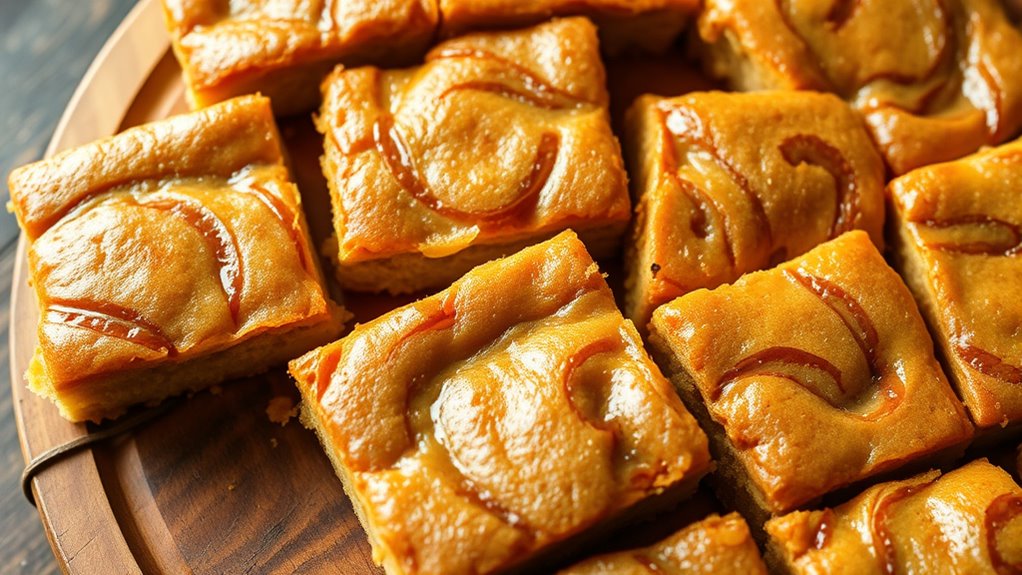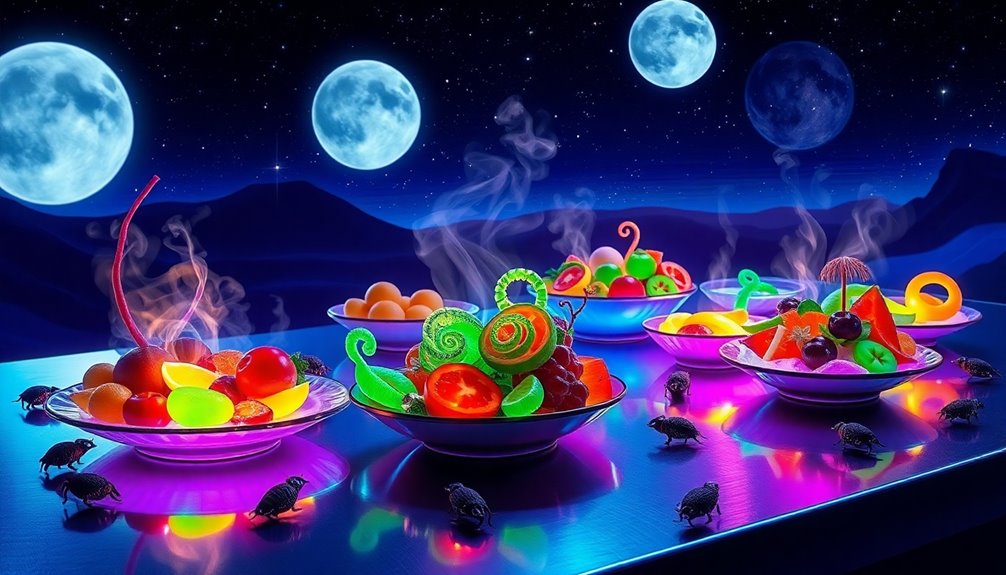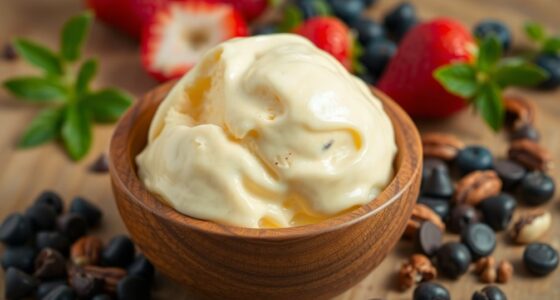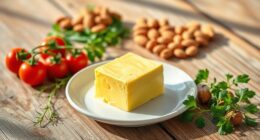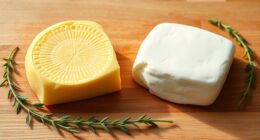When making brown butter blondies, it’s easy to get mixed up about browning and the Maillard reaction. Brown butter mainly involves the Maillard reaction of milk solids, creating rich flavors and color. However, caramelization of sugar also plays a role. Proper temperature and timing are key to achieving the perfect golden crust without burning. Keep in mind, many common myths about these reactions can steer you wrong—continue exploring to master the science behind your best blondies.
Key Takeaways
- The Maillard reaction involves proteins and sugars, not just browning butter, clarifying common misconceptions.
- Browning butter primarily results from the Maillard reaction of milk solids, not overall butter color.
- Achieving optimal blondie color depends on precise temperature control, not just the presence of browned butter.
- Caramelization and Maillard reactions are distinct; caramelization involves sugar alone, while Maillard involves proteins and sugars.
- Proper oven calibration and ingredient management ensure consistent browning and flavor development in blondies.
Understanding the Maillard Reaction: The Basics
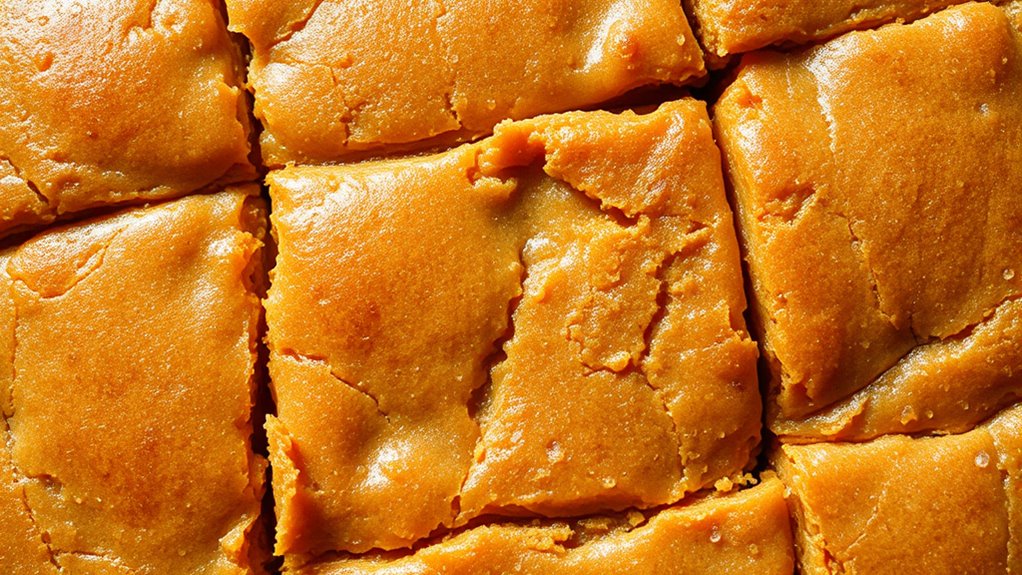
The Maillard reaction is a vital chemical process that occurs when you heat sugars and amino acids together, creating the rich, complex flavors we associate with baked goods. Many caramelization myths suggest it’s the main browning process, but in reality, protein interactions play a significant role. While caramelization involves sugars breaking down at high temperatures, the Maillard reaction depends on amino acids, which come from proteins. This distinction is important because it explains why browned butter and baked items develop such depth of flavor. As heat applies, proteins and sugars interact, forming new compounds that give baked goods their savory aroma and color. Understanding these mechanisms helps you control flavor development, ensuring your blondies achieve the perfect, rich crust without relying solely on caramelization myths. Additionally, the presence of natural materials like wood and stone in farmhouse decor reflects the importance of organic textures in creating authentic, warm atmospheres.
What Happens When You Brown Butter
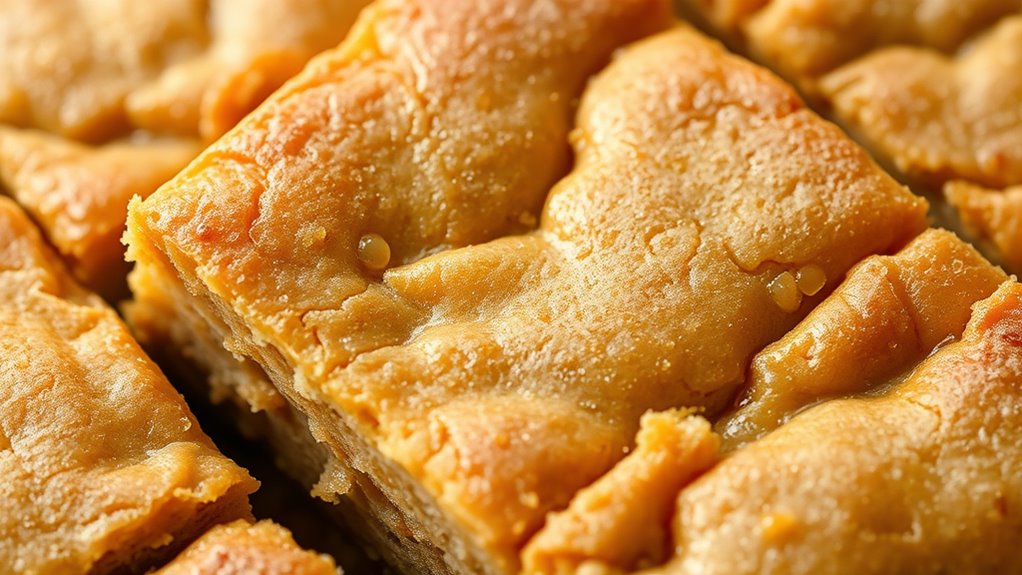
When you brown butter, the heat triggers a series of chemical changes that deepen its flavor and color. Many believe caramelization is the main process, but it’s actually the Maillard reaction happening at lower temperatures. Here’s what you need to know:
- The nuttiness develops as the milk solids brown, not just from caramelization myths.
- Temperature myths suggest you need high heat, but browning occurs between 300°F and 350°F, which isn’t scorching.
- The process involves complex interactions, meaning precise temperature control is less critical than you might think.
Understanding these myths helps you avoid overcooking or burning your butter, ensuring rich flavor without confusion about whether it’s caramelized or just browned.
The Difference Between Browning and the Maillard Reaction
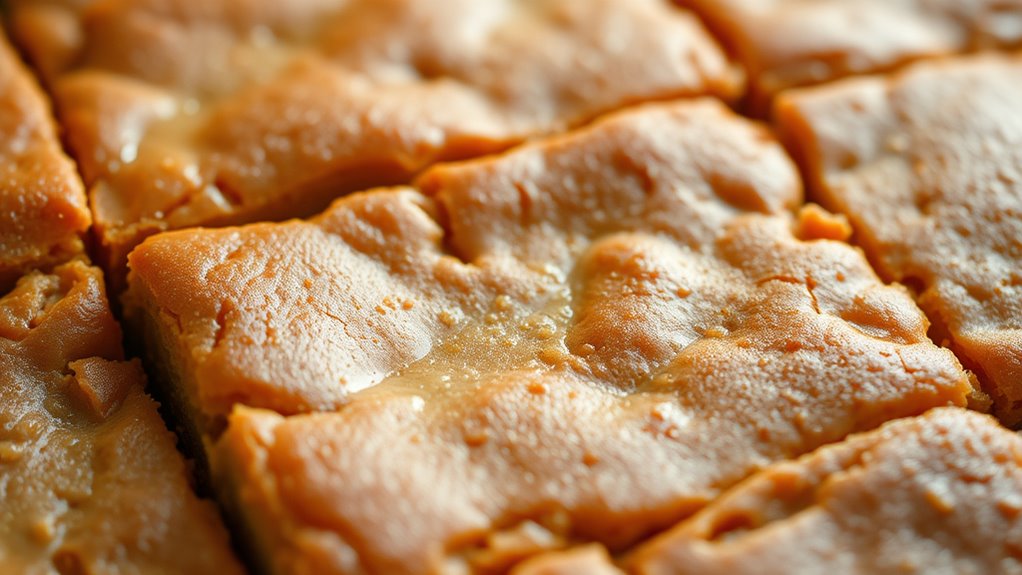
Although browning butter creates rich, nutty flavors, it’s important to understand that this process is distinct from the Maillard reaction, which occurs at a molecular level and involves more than just butter. Browning butter mainly involves the Maillard reaction’s simpler forms, focusing on the ingredient interaction between milk solids and heat. The Maillard reaction influences color perception, producing browns and ambers across various foods, not limited to butter. To clarify:
| Process | Affects | Key Outcome |
|---|---|---|
| Browning Butter | Butter alone | Nutty flavors, color change |
| Maillard Reaction | Proteins + sugars in many foods | Complex flavors, browning |
| Ingredient Interaction | Multiple ingredients | Diverse flavor profiles |
| Color Perception | Visual cues in cooking | Browning, caramelization |
This distinction helps you understand how each process contributes uniquely to your baked goods. Additionally, understanding the chemical reactions involved can help you better control flavor development during cooking.
How Sugar and Proteins Interact During Baking

During baking, sugar and proteins actively interact to create complex flavors and contribute to the browning process. As heat rises, proteins denature, unfolding and exposing amino acids, which then react with sugars. This process enhances flavor depth and promotes browning. Here’s what happens:
During baking, sugar and proteins interact to deepen flavor and promote browning.
- Sugar crystallization slows down as heat causes sugars to dissolve, preventing graininess and ensuring a smooth texture.
- Protein denaturation exposes reactive sites, fostering Maillard reactions that give baked goods their rich, caramelized taste.
- The interaction between dissolved sugars and denatured proteins intensifies browning, adding flavor complexity and appealing color to your blondies.
- Techniques such as field recording and sound synthesis can be employed to capture or create auditory elements that complement the sensory experience of baking.
Understanding these interactions helps you control texture and color, making your baking more precise and delicious.
Common Misconceptions About Brown Butter and Color
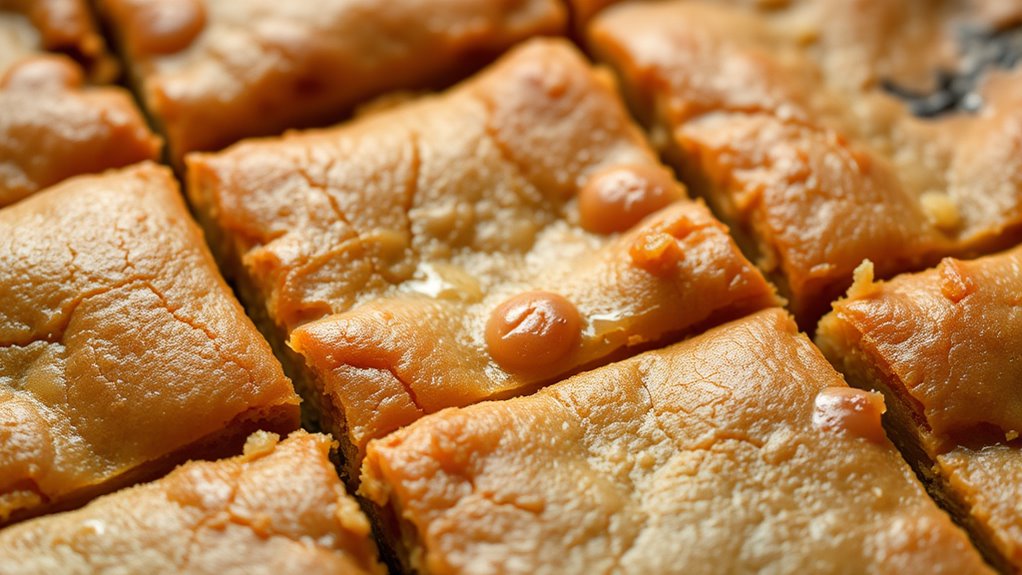
Many people believe that simply browning butter always results in a uniform, dark color, but in reality, the process is more nuanced. Butter clarity plays a key role; as butter browns, its clarity decreases, and the milk solids begin to caramelize at different rates. This uneven caramelization affects the final color, meaning you won’t get a perfectly uniform hue every time. Instead, the caramelization depth varies depending on heat and time, creating a spectrum from golden to deep amber. Rushing the process or using high heat can lead to uneven browning, while controlled heat develops richer, more complex flavors without overdoing the color. Understanding these subtle factors helps you achieve the desired color and flavor in your blondies, dispelling the misconception that browning butter always results in a uniform shade.
The Science Behind Blondie Color and Flavor
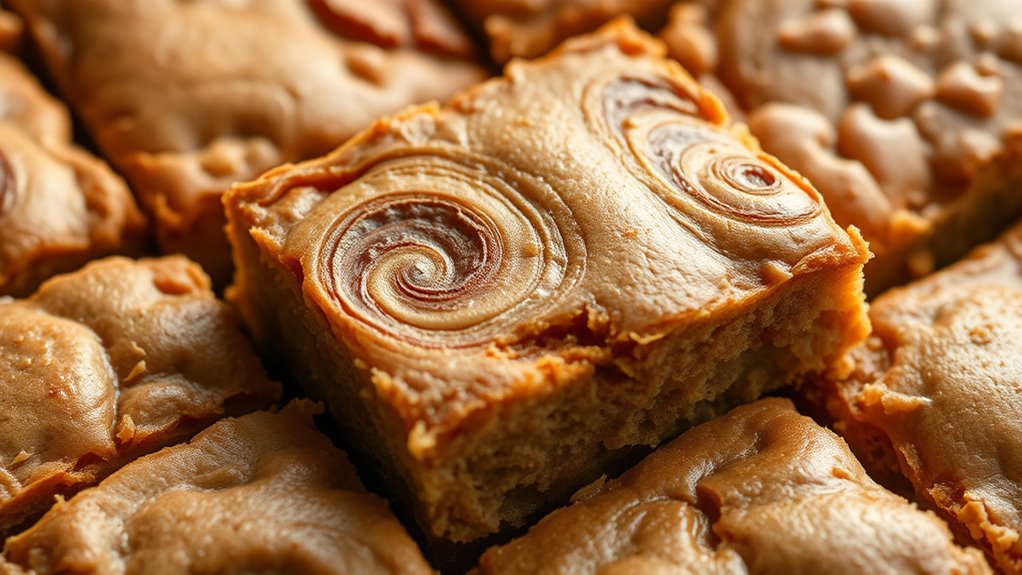
The color and flavor of blondies are directly influenced by the chemical changes that occur during the browning process. When you bake, sugar caramelization happens as heat transforms sugars into rich, amber tones and complex flavors. Simultaneously, protein denaturation occurs in eggs and dairy, altering their structure and contributing to the blondie’s texture and taste. Additionally, understanding the Louisiana Alimony Laws helps in recognizing how financial and legal factors can influence baking decisions and adjustments. Here’s what you should know:
- Sugar caramelization creates the golden color and develops sweet, nutty flavors.
- Protein denaturation in eggs enhances the structure and adds depth to the flavor profile.
- Both processes work together, giving blondies their distinctive color and rich taste without the need for Maillard reactions.
Factors That Influence Browning in Blondies

Your blondies’ color and flavor are shaped by factors like sugar content and oven temperature. Higher sugar levels promote browning through caramelization, while too much can make them overly dark. Similarly, baking at the right temperature guarantees even browning without burning, giving you that perfect golden finish. Ensuring proper mammography guidelines can help detect issues early, much like how controlling baking conditions ensures optimal browning.
Sugar Content and Browning
Sugar content plays a crucial role in browning blondies because it reacts during baking to produce the desirable golden crust. The amount of sugar influences the browning process, affecting both appearance and flavor. Too much sugar accelerates caramelization, leading to a darker crust, while too little results in a paler finish. To optimize browning, consider these factors:
- Higher sugar levels promote faster browning through caramelization.
- The type of sugar (granulated, brown, or specialty sugars) impacts the rate of browning.
- Balancing sugar content ensures even browning without burning or underdeveloped crusts.
Understanding how sugar content affects the browning process helps you achieve the perfect blondie crust—golden, flavorful, and visually appealing every time.
Oven Temperature Effects
Oven temperature substantially influences how blondies brown during baking, directly affecting their color, texture, and flavor. If your baking temperature is too high or your oven isn’t properly calibrated, you might get burnt edges or undercooked centers. Maintaining an accurate oven calibration ensures consistent results. Adjusting the baking temperature can help you control the Maillard reaction and caramelization, leading to the desired golden hue. Use the table below to understand how different oven settings impact browning:
| Baking Temperature | Resulting Browning Effect |
|---|---|
| Low (300°F) | Light, minimal browning |
| Moderate (350°F) | Even, ideal browning |
| High (400°F) | Rapid, possibly burnt edges |
Always verify your oven calibration for precise control over your blondies’ final color. Additionally, understanding browning mechanisms can help you fine-tune your baking process for perfect results.
How to Achieve the Perfect Blondie Without Confusing the Reactions

To get that perfect blondie, you need to focus on flavor development and temperature control. Keeping your oven steady guarantees the reactions happen just right, without overbaking or underbaking. When you manage these factors, your blondies will turn out consistently delicious and beautifully textured.
Flavor Development
Achieving the rich, caramelized flavor of a perfect blondie hinges on understanding how different reactions contribute to its taste. Caramelization differences influence the depth of sweetness and complexity, so selecting the right sugar type matters. Use flavor enhancement techniques like browning butter or adding vanilla to amplify the overall profile. To maximize flavor:
- Focus on caramelization differences by controlling sugar types and cooking times.
- Incorporate browned butter or toasted nuts to deepen flavor layers.
- Use ingredients like vanilla or salt strategically for subtle flavor boosts.
- Paying attention to temperature control during baking can prevent over- or under-caramelization, ensuring optimal flavor development.
Temperature Control
Controlling the baking temperature is essential for guaranteeing your blondie develops the perfect texture and flavor without confusing the underlying chemical reactions. Too high a temperature can cause excessive sugar crystallization, leading to a gritty texture, while too low may result in an undercooked center. To achieve even baking, ensure your oven has good heat distribution, preventing hot spots that could unevenly cook your blondies. Use an oven thermometer to verify accuracy, and consider rotating your pan halfway through baking. Maintaining a steady, moderate temperature allows the Maillard reaction and sugar caramelization to develop properly, enhancing flavor without overdoing it. Precise temperature control helps you strike the right balance for a tender, golden blondie with complex, well-rounded flavors. Additionally, understanding thermal dynamics can help you better predict how your baked goods will respond to specific temperature settings.
The Role of Temperature and Time in Browning Processes
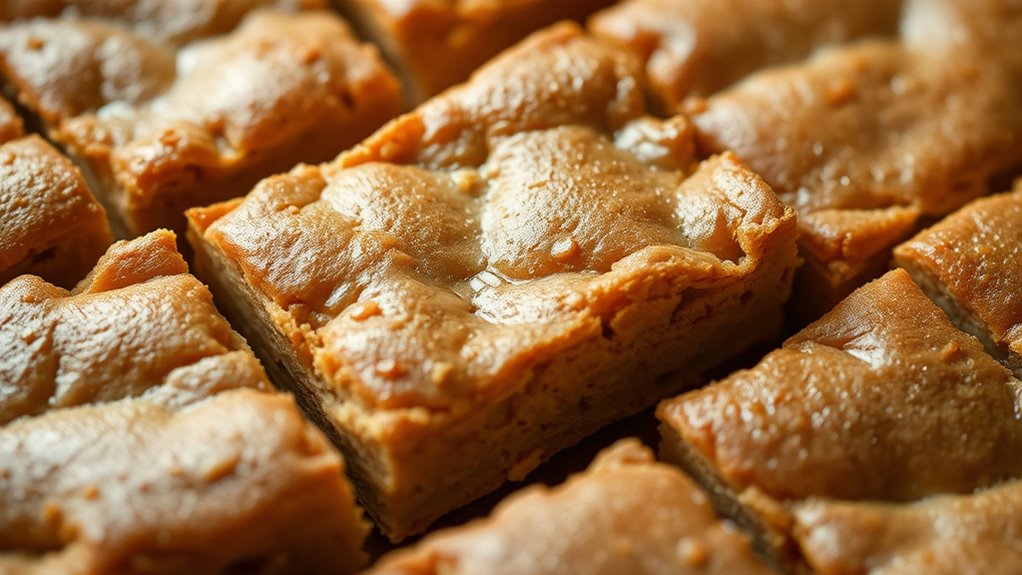
Temperature and time are critical factors that influence how browning occurs in blondies. Proper heat application affects caramelization nuances and determines the depth of flavor. Too much heat or too long baking can lead to burnt edges, while too little might result in underdeveloped flavor. Here’s what you should consider:
Temperature and timing are key to achieving perfect blondie browning and flavor depth.
- Use a consistent oven temperature to avoid uneven browning.
- Keep an eye on baking time to balance caramelization without overcooking.
- Recognize that gradual heat application helps develop complex flavors without burning the sugars.
- Leveraging innovative heating technologies can further optimize browning and flavor development in baked goods.
Tips for Baking More Flavorful and Visually Appealing Blondies
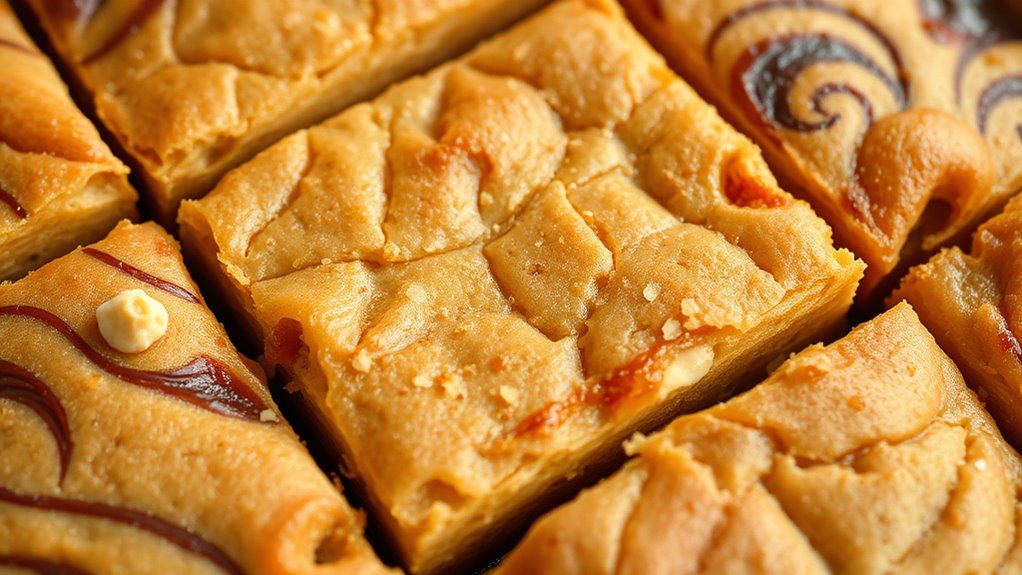
To make your blondies more flavorful, focus on enhancing the browning depth by using ingredients like browned butter and a touch of molasses. Adding visual accents, such as chocolate chips or nuts, can also make them more appealing. These small touches will boost both the taste and the look of your baked treats. For an even more refined flavor, consider using seasonal baking tips to adjust your ingredients and timing for optimal results.
Enhance Browning Depth
Have you ever wondered how to deepen the golden-brown hue and enhance the rich flavor of your blondies? Achieving a darker, more flavorful crust relies on understanding caramelization differences and protein interactions. To boost browning depth, try these tips:
- Increase oven temperature slightly—a higher heat accelerates caramelization without burning the edges.
- Use a sugar-rich batter—more sugar promotes caramelization differences, developing deeper color and richer flavors.
- Pre-bake or partially cook the batter—this allows proteins and sugars to interact more fully, enhancing browning and flavor complexity.
Use Visual Accents
Adding visual accents to your blondies can make them more enticing and memorable. You can achieve this by drizzling caramel or chocolate on top, sprinkling colorful sea salt, or adding edible flowers for elegance. These accents not only elevate the presentation but also suggest complementary food pairings, enhancing the overall flavor experience. Consider ingredient substitutions like using toasted nuts or dried fruit to add texture and visual interest. For a more sophisticated look, swirl in fruit preserves or caramel before baking. These visual touches guide the eye and hint at flavor layers, making your blondies irresistible. Remember, a beautifully decorated blondie invites curiosity and enhances taste perception, turning a simple treat into a memorable dessert experience.
Frequently Asked Questions
Can Different Fats Affect the Maillard Reaction in Blondies?
Different fats can influence the Maillard reaction in blondies because of their fat composition and oil smoke point. Fats with higher smoke points, like clarified butter or refined oils, can withstand higher baking temperatures without breaking down, helping the Maillard process occur properly. Conversely, fats with lower smoke points, such as unrefined oils, may burn or produce off-flavors, affecting browning and flavor development in your blondies.
Does the Type of Sugar Alter Browning and Flavor Development?
Think of sugar as the artist behind the scenes, shaping browning and flavor. Different sugars, like brown or white, influence sugar crystallization and flavor extraction, impacting how your blondies develop their rich, caramelized notes. Brown sugar, with its molasses, promotes deeper browning, while white sugar yields a lighter color. So, choosing your sugar type directly affects the flavor complexity and visual appeal—making every bite uniquely delicious.
How Does Humidity Impact Browning in Baked Blondies?
Humidity effects can considerably influence browning in baked blondies. When humidity is high, moisture retention in your batter increases, which slows down browning and can result in a paler crust. Conversely, lower humidity allows moisture to evaporate more quickly, promoting better browning. To get the perfect color, you might need to adjust baking time or temperature based on your environment’s humidity, ensuring your blondies develop that desirable golden crust.
Are There Alternative Methods to Enhance Flavor Without Browning?
If you want to enhance flavor without browning, try flavor infusion techniques like soaking ingredients in spirits or extracts before baking. You can also use ingredient substitutions, such as swapping vanilla extract for almond or adding spices like cinnamon or nutmeg, to boost taste without altering browning. These methods let you customize your blondies’ flavor profile while maintaining a lighter color and avoiding Maillard reactions.
What Role Do Antioxidants Play in Browning and Flavor Stability?
Imagine you’re baking cookies and want to keep their fresh flavor longer. Antioxidants help by slowing oxidation, which affects browning and flavor stability. Their antioxidant effects preserve the natural taste, preventing undesirable changes. For example, adding vitamin E to baked goods can enhance flavor preservation by protecting fats from rancidity. So, antioxidants play a vital role in maintaining both the appearance and flavor quality of your baked treats.
Conclusion
Now that you know the nuances of browning and the Maillard reaction, you can confidently create beautifully baked blondies. By balancing temperature, timing, and technique, you’ll master the art of achieving luscious, caramelized color without confusion. Remember, understanding the science simplifies the sweet, satisfying process. So, embrace the baking basics, banish the myths, and bring bold, beautiful blondies to life—deliciously, deliberately, and with delightful detail.
